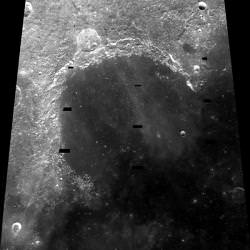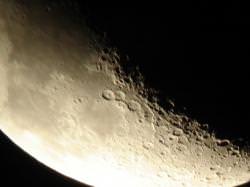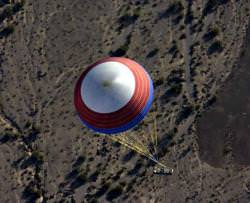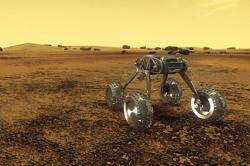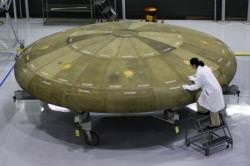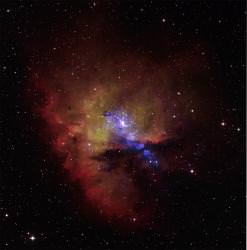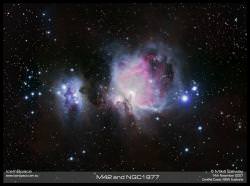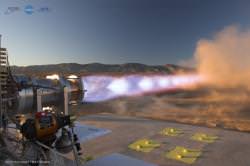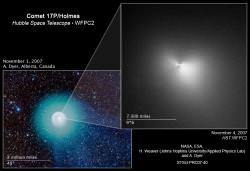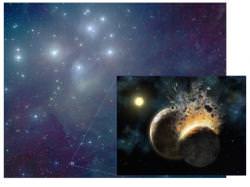Monday, November 19 – Even if you only use binoculars tonight, you can’t miss the beautiful C-shape of Sinus Iridium as it comes into view on the lunar surface. As we have learned, the mountains that ring it are called the Juras, and the crater punctuating them is named Bianchini. Do you remember what the bright tips of the opening into the “Bay of Rainbows” are called? That’s right: Promontorium LaPlace to the northeast and Promontorium Heraclides to the southwest. Now take a good look at Heraclides… Just south of here is where Luna 17 landed, leaving the Lunokhod rover to explore!
Now turn your eyes or binoculars just west of bright Aldebaran and have a look at the Hyades Star Cluster. While Aldebaran appears to be part of this large, V-shaped group, it is not an actual member. The Hyades cluster is one of the nearest galactic clusters, and it is roughly 130 light-years away in the center. This moving group of stars is drifting slowly away towards Orion, and in another 50 million years it will require a telescope to view!
Tuesday, November 20 – Today celebrates another significant astronomer’s birth – Edwin Hubble. Born 1889, Hubble became the first American astronomer to identify Cepheid variables in M31 – which in turn established the extragalactic nature of the spiral nebulae. Continuing with the work of Carl Wirtz, and using Vesto Slipher’s redshifts, Hubble then could calculate the velocity-distance relation for galaxies. This has become known as “Hubble’s Law” and demonstrates the expansion of our Universe.
Tonight we’re going to ignore the Moon and head just a little more than a fistwidth west of the westernmost bright star in Cassiopeia to have a look at Delta Cephei (RA 22 29 10.27 Dec +58 24 54.7). This is the most famous of all variable stars and the granddaddy of all Cepheids. Discovered in 1784 by John Goodricke, its changes in magnitude are not due to a revolving companion – but rather the pulsations of the star itself.
Ranging over almost a full magnitude in 5 days, 8 hours and 48 minutes precisely, Delta’s changes can easily be followed by comparing it to nearby Zeta and Epsilon. When it is its dimmest, it will brighten rapidly in a period of about 36 hours – yet take 4 days to slowly dim again. Take time out of your busy night to watch Delta change and change again. It’s only 1000 light-years away, and doesn’t even require a telescope! (But even binoculars will show its optical companion…)
Wednesday, November 21 – Tonight the gibbous Moon will dominate the sky. If you haven’t had a chance to log some features like Copernicus, Gassendi, Tycho and Plato – be sure to pick them up before the glare overpowers them. While you’re there, be sure to look for “the Man in the Moon!”
Now, let’s continue our stellar studies with the central-most star in the lazy “W” of Cassiopeia – Gamma…
At the beginning of the 20th century, the light from Gamma appeared to be steady, but in the mid-1930s it took an unexpected rise in brightness. In less than 2 years it jumped by a magnitude! Then, just as unexpectedly, it dropped back down again in roughly the same amount of time. A performance it repeated some 40 years later!
Gamma Cassiopeiae isn’t quite a giant and is still fairly young on the evolutionary scale. Spectral studies show violent changes and variations in the star’s structure. After its first recorded episode, it ejected a shell of gas which expanded Gamma’s size by over 200% – yet it doesn’t appear to be a candidate for a nova event.
The best estimate now is that Gamma is around 100 light-years away and approaching us a very slow rate. If conditions are good, you might be able to telescopically pick up its disparate 11th magnitude visual companion, discovered by Burnham in 1888. It shares the same proper motion – but doesn’t orbit this unusual variable star. For those who like a challenge, visit Gamma again on a dark night! Its shell left two bright (and difficult!) nebulae, IC 59 and IC 63, to which we will return at the end of the month.
Thursday, November 22 – As our observing year draws to a close, let’s take another look at a feature you might have missed – Wargentin. Located in the southwest quadrant on the terminator just south of the larger crater Schickard, we return again because Wargentin is one of the Moon’s most well-known curiosities. Able to be captured in binoculars, but best seen through a telescope at high power, really take a look at what was once a normal small crater! Unlike most craters, Wargentin’s walls were solid – able to contain the lava which eventually filled it to a height of 84 meters above the lunar surface.
While at first you might not notice, compare it to nearby Nasmyth and Phocylides. While both of these craters go below the surface, they also contain interior strikes – Wargentin has none! Except for a gentle, unnamed rille across its elevated surface, Wargentin is smooth.
While we still have about a month until it reaches opposition, the “Red Planet” is always worthy of a little attention. While Mars isn’t at its closest right now, this will be the only time this year that we can view it in the evening. Catch it now – before the Moon catches up with it in the days ahead!
Friday, November 23 – Tonight in 1885, the very first photograph of a meteor shower was taken. Also, the weather satellite TIROS II was launched on this day in 1960. Carried to orbit by a three-stage Delta rocket, the “Television Infrared Observation Satellite” was about the size of a barrel, testing experimental television techniques and infrared equipment. Operating for 376 days, Tiros II sent back thousands of pictures of Earth’s cloud cover and was successful in its experiments to control the orientation of the satellite spin and its infrared sensors. Oddly enough, a similar mission – Meteosat 1 – also became the first satellite put into orbit by the European Space Agency, in 1977 on this day. Where is all this leading? Why not try observing satellites on your own! Thanks to wonderful on-line tools from NASA you can be alerted by e-mail whenever a bright satellite makes a pass for your specific area. It’s fun!
Now, let’s explore tonight’s lunar feature – Galileo. It is a challenge for binoculars to spot this feature, but telescopes of any size capable of higher power will find it easily on the terminator in the west-northwest section of the Moon. Set in the smooth sands of Oceanus Procellarum, Galileo is a very tiny, eye-shaped crater and has a soft rille that accompanies it. It was named for the very man who first viewed and contemplated the Moon through a telescope. No matter what lunar resource you choose to follow, all agree that giving such an insignificant crater a great name like Galileo is unthinkable! For those of you familiar with some of the outstanding lunar features, read any good account of Galileo’s life and just look at how many spectacular craters were named for people he supported! We cannot change the names of lunar cartography, but we can remember Galileo’s many accomplishments each time we view this crater
Saturday, November 24 – Tonight it is Full “Frost Moon” and there is little doubt about how its name came to be! For those of you interested in viewing lunar features tonight, libration could be favorable to study a collection of shallow, dark craters known as Mare Australe. Located on the southeastern limb, this large binocular and telescopic object is well-worth looking for because it’s a challenge that isn’t always visible.
Ready to aim for a bullseye? Then head for the bright, reddish star Aldebaran. Set your eyes, scopes or binoculars there and let’s look into the “eye” of the Bull.
Known to the Arabs as Al Dabaran, or “the Follower,” Alpha Tauri took its name for the fact that it appears to follow the Pleiades across the sky. In Latin it was Stella Dominatrix, yet the old English knew it as Oculus Tauri, or very literally the “eye of Taurus.” No matter which source of ancient astronomy lore we explore, there are references to Aldeberan.
As the 13th brightest star in the sky, it almost appears from Earth to be a member of the V-shaped Hyades star cluster, but its association is merely coincidental, since it is about twice as close to us as the cluster. In reality, Aldeberan is on the small end as far as K5 stars go, and like many other orange giants could possibly be a variable. Aldeberan is also known to have five close companions, but they are faint and very difficult to observe with backyard equipment. At a distance of approximately 68 light-years, Alpha is only about 40 times larger than our own Sun and approximately 125 times brighter. To get a grasp on that size, think of it as being about the same size as the area Earth’s orbit! Because of its position along the ecliptic, Aldeberan is one of the very few stars of first magnitude that can be occulted by the Moon.
Sunday, November 25 – While Cassiopeia is in prime position for most northern observers, let’s return tonight for some additional studies. Starting with Delta, let’s hop to the northeast corner of our “flattened W” and identify 520 light-year distant Epsilon. For larger telescopes only, it will be a challenge to find this 12″ diameter, magnitude 13.5 planetary nebula I.1747 in the same field as magnitude 3.3 Epsilon!
Using both Delta and Epsilon as our “guide stars” let’s draw an imaginary line between the pair extending from southwest to northeast and continue the same distance until you stop at visible Iota. Now go to the eyepiece…
As a quadruple system, Iota will require a telescope and a night of steady seeing to split its three visible components. Approximately 160 light-years away, this challenging system will show little or no color to smaller telescopes, but to large aperture, the primary may appear slightly yellow and the companion stars a faint blue. At high magnification, the 8.2 magnitude “C” star will easily break away from the 4.5 primary, 7.2″ to the east-southeast. But look closely at that primary: hugging in very close (2.3″) to the west-southwest and looking like a bump on its side is the B star!
Dropping back to the lowest of powers, place Iota to the southwest edge of the eyepiece. It’s time to study two incredibly interesting stars that should appear in the same field of view to the northeast. When both of these stars are at their maximum, they are easily the brightest of stars in the field. Their names are SU (southernmost) and RZ (northernmost) Cassiopeiae and both are unique! SU is a pulsing Cepheid variable located about 1000 light-years away and will show a distinctive red coloration. RZ is a rapidly eclipsing binary that can change from magnitude 6.4 to magnitude 7.8 in less than two hours. Wow!

